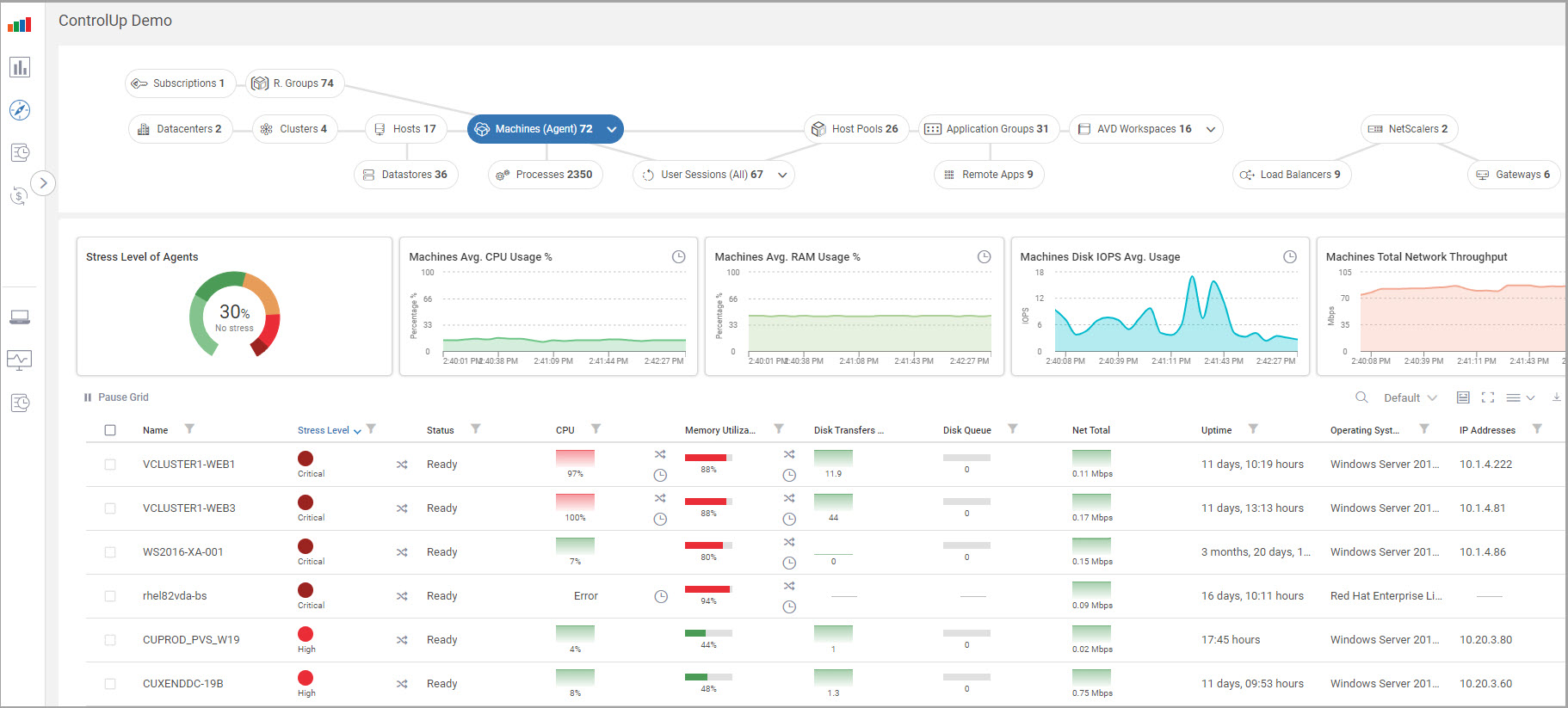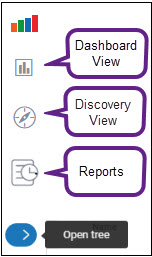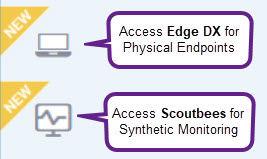Welcome to Solve. ControlUp Solve offers you powerful real-time monitoring and comprehensive analysis in a hosted web application. If you use a Hybrid Cloud environment, see web UI.
Accessing via a web interface means there's less resource consumption on the endpoints that are logging in and viewing the data, providing you and your users a leaner, more performance-driven experience.
Solve provides a wide range of functionalities including:
Dashboard widgets that have been configured to provide you the latest, most relevant information on your environments, right out-of-the-box.
Discovery with topology view of your environment that displays the relationships between components. Discovered components are displayed dynamically. You can drill down from each component to access detailed performance information. See more details below.
Drill down from any component in the topology or dashboard widgets with powerful contextual navigation built from our recommendations engine.
Data grids from the ControlUp console with a more modern look and feel and lots of new features.
Historical Trends for metrics related to machines and hosts.
Reports available directly in the Solve interface. You can now view new, constantly updated data pipeline reports, and older data in legacy reports.
To learn more about the Contextual Navigation, watch our video.
How to Access the Web UI
Navigation

Use the main navigation bar on the left side gives to select how the data is displayed and which data to display.
Tree

Your organization is represented in the same tree structure as in the ControlUp console. You can choose to open and close the tree with an open triangle icon on the left side below the page navigation icons.
The data in the Dashboard and Discovery views are displayed on the Solve web page, based on the context you selected in the organization tree. For example, if you set up a folder in the ControlUp console to represent the components that belong to a certain team in your organization, when you highlight that folder in Solve, only the performance and monitoring data for those components are displayed in the topology, widgets, and columns.
When a folder is highlighted in the tree affecting the data displayed, the following message displays what data you are viewing: Focusing on: < folder name >.
Dashboard View
The dashboard provides out-of-the-box widgets with easy-to-understand visual indicators of many of the metrics, performance indicators, and details found in ControlUp. These widgets provide you more insight so you can better understand the performance and status of your whole environment. The out-of-the-box widgets include the following:
Single statistics. For example, the number of running hosts, average logon duration in seconds, datastore free space in terabytes.
Gauges. Computed based on data types, for example, session and process stress levels.
Bar graphs. Categorized data on specific metrics, including:
Top 5 processes by CPU usage
Top 5 processes by memory utilization
Top 5 processes by disk usage
Top user sessions by CPU consumption
Slowest logons
Line graphs. Analyzing data from different sources. For example, averages, usage percentages, and usage over time.
If you drill down into any of the widgets, you can see the Discovery view that includes the new Topology view and the data grid below. You see this data based on the context of which widget you clicked in the Dashboard view and its related metrics.
Running Processes
On the dashboard, the Running Processes widget displays the total number of running processes. If you drill down from this widget, the Processes topology element displays the total number of monitored processes, which is less than the total running processes.
Discovery View with Topology
The Discovery View enables you to perform accurate investigations on real-time data. The data displayed provides you with accurate and targeted information on your systems so you can efficiently discover issues as they arise.
There are dedicated pages with specific widgets and columns depending on what you choose to highlight in the topology at the top of the page.
Topology

The topology feature displays your organization visually, showing the connections between all the elements in your monitored environment. Each of the elements can be drilled down to provide you with more information and monitoring details.
When drilling down from the topology, the elements are displayed in the dashboard widgets and grid below.
When drilling down to objects in the dashboard or the grid, use the topology to navigate between the objects that are related to the element you drilled down to, both parent and child elements.
Drilldowns
Click on a widget on the dashboard, or an en entity in the real-time grid, to drill down and see more relevant information. Solve shows you the most relevant information based on what you drilled down into.
You can also drill down into specific metrics in the real-time grid. For example, clicking on a CPU metric for a machine drills down into more CPU-related data for that machine.
After you drill down, you can continue to navigate or drill down further until you get the information you need. At the top of the screen you can keep track of where you have navigated. You can go back a step, or completely close exit out of the drilldown to return to the location where you started the drilldown.

The Topology at the top of the solve screen also changes based on what you might have accessed in the grid.
Grid with Grid Options

Columns options:
Search
Enlarge / Decrease column grid
Grid at full screen
Select columns
If you find that there are columns that you want to see that are not appearing in your view, you can search and add more columns. You can save your view and restore defaults to revert to the ControlUp suggested column view.
Historical Trends
While Solve's power lies in its real-time monitoring, you can also use it to view historical trends on any metrics related to machines and hosts. These metrics are available for single entities, multiple entities, and for the relevant Dashboard Widgets. See Historical Trends in Solve for full details on this feature.
Reports
Access Solve reports to identify trends about user activity, system health, and application usage. Use the data from the report metrics to take actions to optimize your environment, and improve system functionality and the user experiences throughout your organization. For more details, see VDI and DaaS Reports.
Access to Scoutbees and Edge DX
In the Solve left-hand menu, you can access Scoutbees and Edge DX interfaces.
Click the Physical Endpoints icon to access the Edge DX interface. Edge DX enables you to monitor physical devices and endpoints located anywhere – without requiring VPNs or cloud gateways. Edge DX is a systems and device management SaaS for desktop, Mac, IGEL, and other devices, with features for monitoring, troubleshooting, and gathering intelligence across remote devices. For details, see Welcome to Edge DX.
Click the Synthetic Monitoring icon to access the Scoutbees interface. This SaaS application reduces downtime and proactively monitors the availability and health of your corporate applications. You can enable synthetic monitoring for published resources through the EUC used in your environment, such as Citrix Virtual Apps and Desktops or VMware Horizon, or any Network resource such as those that can be delivered as a web service, API, or website. Click here to access Scoutbees documentation.
Solve Access and Login
You can access Solve either directly via URL or from the ControlUp Console. First-time access must be done through the Console. You use a secure one-time passcode (OTP) to login to both ControlUp and Solve.
When you access via a URL, you must also identify a ControlUp organization name at the end of the URL: https://solve.controlup.com/ORG_NAME where ORG_NAME is your ControlUp organization's name.
For details on how to configure login settings and access Solve, see Login Flow for The ControlUp Console v8.2 and Up & Solve 1.0 and Up.